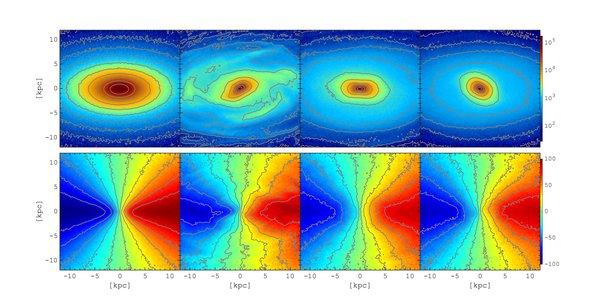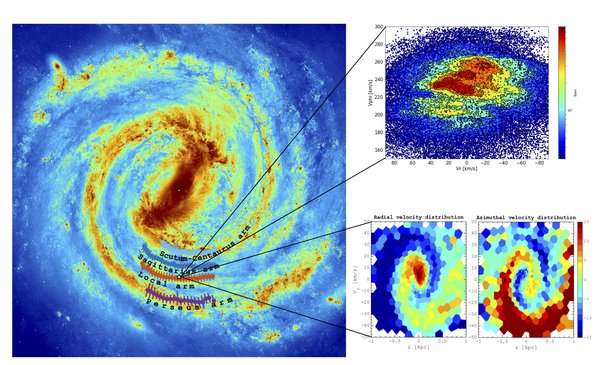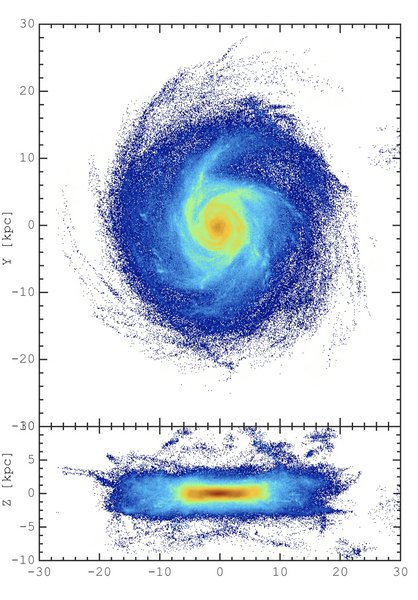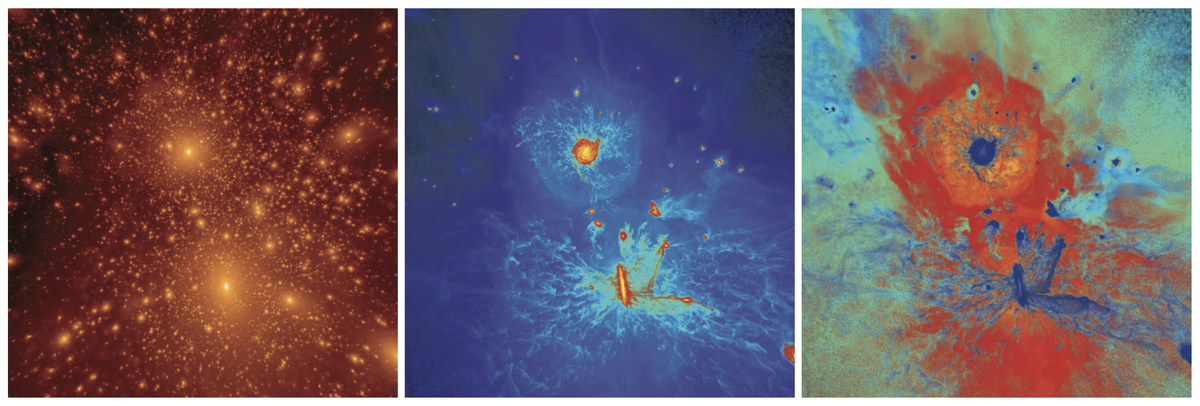Modelling and Simulations
The Milky Way and the Local Volume section develops a range of models aimed at understanding the structure and formation of galaxies like the Milky Way, its satellites, and nearest neighbors. We study fundamental problems in the evolution of disk galaxies, such as disk growth and thickening, perturbations from collisions with dwarf galaxies, gas accretion, angular momentum redistribution, and the formation of central bars and spiral structure. Chemical evolution models are used to understand the chemical abundance patterns seen in large Galactic surveys, with a particular interest in the oldest and most metal-poor stars. Hydrodynamical simulations of the growth of disk galaxies in the cosmological context help us understand the place of the Milky Way in relation to the Local Group of galaxies. Combining these modelling techniques into our newest full chemo-dynamical cosmological models is critical for understanding the results of the Gaia space mission.
Galaxy disk dynamics

Evolution of density distribution (top) and line-of-site velocity (bottom) of a barred galaxy simulated with N-body code
Credit: Sergey Khoperskov, AIPThe formation and evolution of galactic disks is governed by both internal and external perturbations. We use high-resolution N-body models and hydrodynamical simulations in the cosmological context to study the effect of galactic bars, spiral arms, and infalling satellites on the disk kinematical heating, stellar and gas angular momentum redistribution (radial migration), and vertical disk asymmetries. These processes can radially mix stellar populations over timescales of a few Gyr with efficiency dependent on the bar and spiral arms parameters, most importantly their strengths, pattern speeds, and longevity. Angular momentum is exchanged not just among stars in the disk but also between the disk baryons and the dark matter halo. We investigate the structure and formation of the thin and thick disks, the disk outskirts, and the response to galaxy mergers and flybys.
The predictions we make are tested on both observations of external disk galaxies (such as the GHOSTS and CALIFA surveys) and on data from large Milky Way surveys, e.g., RAVE, APOGEE, Gaia, and soon 4MOST.
Understanding the Milky Way present-day structure

Left: An artist’s impression of the Milky Way structure with the spiral arms constrained by the Gaia DR2 measurements. Top right: kinematic moving groups in the Solar vicinity. Bottom right: phase-space spiral across the Galactic plane
Credit: Sergey Khoperskov, AIPThe Milky Way system offers a unique test-bed for the predictions of galaxy evolution theories. A first step in uncovering the Milky Way formation history is understanding its current morphological and kinematical state, which is largely obscured due to our position inside the disk. Until recently that was possible mainly indirectly, by comparing the expected structure from bar and spiral resonances on the local stellar velocity field. With the acquisition of data covering larger distances from the Sun, about a third of the Milky Way disk has now been mapped with 6D kinematics and chemical abundances, reaching both the central bulge/bar region and the outer disk.
The unprecedented quality of Gaia data (astrometric space mission of the European Space Agency) has revealed a rich structure in the multidimensional chemo-kinematical phase-space in the extended Solar vicinity, manifesting an out-of-equilibrium Galaxy. This calls for modeling the Milky Way as an evolving, non-stationary system. Using high-resolution simulations and orbit integrations, we study the nature of various features found in the stellar phase-space and their relevance to external (interaction with satellites) and internal (GMC, spiral arms and bar resonances) agents. Contrasting our models with data from Gaia and ground-based spectroscopic surveys helps us constrain the Milky Way's present-day structure, including the bulge, bar, and spiral arms parameters.
Assembly and formation history of the Milky Way

Face-on (top) and edge-on (bottom) projections of the stellar density in a chemo-dynamical simulation of the formation of a Milky Way-type galaxy with a number of dwarf galaxies merging at early epochs
Credit: Sergey Khoperskov, AIPBecause of the effects of radial migration, the stellar positions and kinematics alone cannot help us recover the Galactic evolutionary history. To achieve this, we build models that simulate the entire Milky Way evolution, including the star-formation history and chemical enrichment as a function of time and Galactic radius. These chemo-dynamical models are constraint by the myriad of present-day constraints found in the extremely precise astrometric Gaia data combined with ground-based spectroscopic surveys.
The first two Gaia data releases already showed that our Galaxy's stellar halo is dominated by a massive, possibly single, merger event, known as the Gaia Sausage-Enceladus. Accreted stars associated to this event are identifiable by their kinematics and chemical abundances, although they are radially mixed with stars born in-situ. To understand the Milky Way merger history, we perform high-resolution N-body/hydrodynamical simulations in the cosmological context, aimed at understanding the properties of the satellite progenitors (mass, chemical composition, orbital parameters, dark matter and gas fraction), based off the chemo-kinematical signatures found today.
The chemical enrichment is expected to proceed more slowly in low-mass galaxies than in more massive ones at any given time during the galaxy evolution. This gives us a way to identify accreted stars in the Galaxy by looking for those with specific abundance patterns typical of low-mass galaxies. The least enriched stars give us also insight to the very first star formation occurring in the Universe.
Simulating the Milky Way in the local cosmological environment
In collaboration with the AIP Cosmology section, we run cosmological zoom simulations (the HESTIA project) for which the initial conditions have been constrained to reproduce specific local cosmographic features, such as the super galactic plane, the local void, and the Virgo cluster. HESTIA employs one of the most modern galaxy formation models, in order to form realistic Local Groups in the correct cosmological environment. Accordingly, HESTIA produces pairs of galaxies (and an entourage of smaller dwarfs) that resemble the Milky Way, Andromeda, and M33 in their dynamics, mass and formation history resolved with 2x104 M⊙ gas-mass and 180 pc spatial resolution. Simulations with resolution to 90 pc and stellar mass to 8x103 M⊙ are under construction.
Simulating the Milky Way in the Local Group environment allows us to more precisely explore a number of specific questions. What is the impact of satellite galaxies and larger neighbors, such as Andromeda and M33, on the Milky Way’s
- star formation history as a function of radius and azimuth,
- kinematical heating and disk thickening as function of position,
- stellar and gas accretion,
- disk dark matter distribution, and
- triggering of the formation of the Galactic bar and spiral arms

Final simulation time step for one of the high-resolution HESTIA Local Group (Milky Way, Andromeda, and M33) simulations.The panels show from left to right the dark matter density (white: high density, red-black: low density), gas density (yellow-white: high density, blue-black low density), and density-weighted gas temperature (yellow-red: 106 K hot gas, dark blue: 104 K cold gas).
The two main galaxies are clearly seen as is a smattering of accompanying dwarf galaxies and circum-galactic gas. Panels are 3 Mpc across.
Credit: N. Libeskind